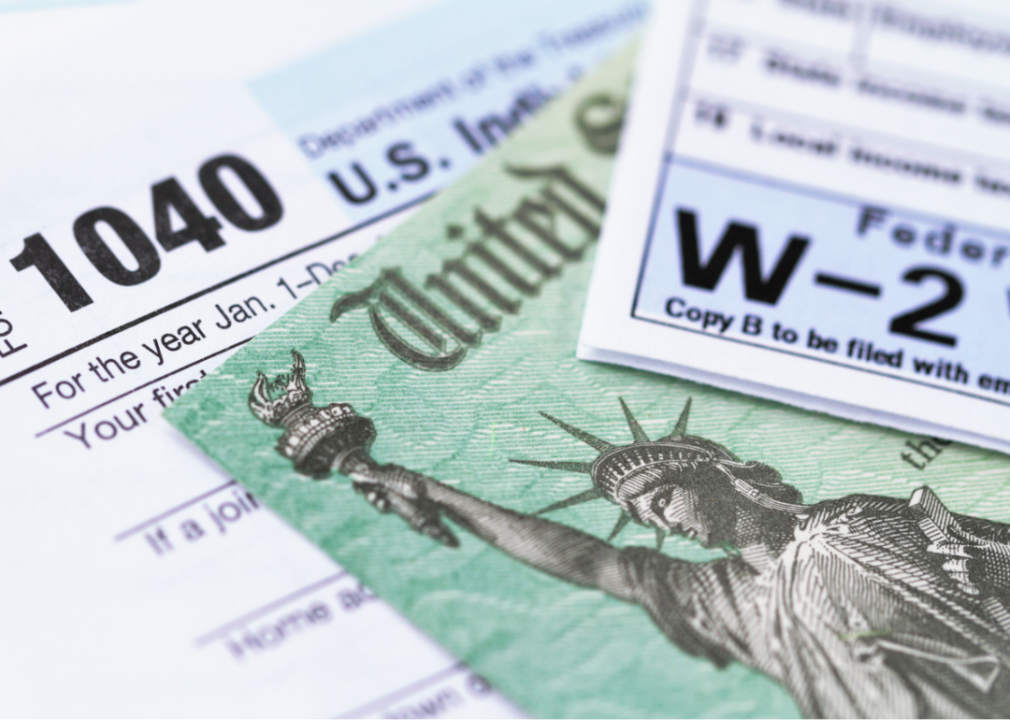It's tax season: Here are the simple rules to file correctly—and on time

Canva
It’s tax season: Here are the simple rules to file correctly—and on time
1040 and W-2 tax forms, with U.S. treasury check
April has a tendency to sneak up on even the savviest of taxpayers. There are several important dates Americans should be aware of in 2024.
Tax season opened on Jan. 29, and the deadline for federal tax returns will be April 15—though that doesn’t apply to everyone. Money outlines the key deadlines and details you need to know in order to file correctly and on time.
When are 2023 taxes due?
Most individual income tax returns for the 2023 tax year are due to the Internal Revenue Service on April 15, 2024. Taxpayers need to file a Form 1040 (or Form 1040-SR, for older adults) and pay any tax due by this date.
Tax Day is usually on or around April 15. If April 15 falls on a Saturday, Sunday or holiday, the tax deadline moves to the next weekday. And if that’s a holiday, it gets pushed back another business day. (The IRS also tends to offer extensions to Americans impacted by national disasters or emergency situations, but that’s a different story.)
Take 2023 as an example. April 15 fell on a Saturday, which would normally mean Tax Day would be pushed to the following Monday. But April 17 was Emancipation Day in Washington D.C., so the official tax deadline was moved to April 18.
In 2024, April 15 is a Monday, so that’s Tax Day for almost everyone. Residents of Maine and Massachusetts have until April 17 to file their federal income taxes because April 15 is Patriots’ Day and April 16 is Emancipation Day.
When can I file my taxes?
Technically, you can do your taxes as soon as you have all of the information and tax documents you need. Tax preparers like TurboTax and H&R Block typically launch their software in November. Many crucial tax forms — like the W-2, 1099-MISC and 1099-NEC — are supposed to be sent out by the end of January. IRS Free File opened up on Jan. 12.
The formal start date for the 2024 tax filing season was Jan. 29. If you filed before the season officially began, your tax preparer has simply held onto your tax year 2023 return until the IRS began its tax processing.
Filing taxes early is smart for many reasons. For one, getting your taxes to the IRS sooner means receiving your refund faster. It also helps prevent fraud. Identity thieves often use stolen Social Security numbers to file people’s taxes and steal their tax refunds. If you beat them to the punch and have already filed by the time they try to, the IRS will reject that return — protecting your tax refund and your personal data in the process.
When are state taxes due?
The information above only applies to your federal tax return. Many states charge income taxes, as well, and they have a different set of important dates.
Most states with income taxes require people to file their state returns by the federal due date (which this year is April 15 or April 17 if you live in Massachusetts or Maine). But there are exceptions.
In New Mexico, for instance, those who e-file get extra time: They don’t have to file until April 30. In Virginia, the state tax deadline is May 1. And in Louisiana, tax returns and payments are due May 15.
Check your state revenue department’s website to find out your 2024 tax filing deadline.
How to file for a tax extension
If you lose track of when taxes are due and you end up needing more time to file, it’s easy to get an automatic extension from the IRS:
- You can pay all or some of your tax bill and denote that it’s for an extension.
- You can submit Form 4868 online (which you can do through IRS Free File regardless of your income).
- You can send in a paper version of IRS Form 4868.
This will give you an extra six months to file your federal taxes, making your new tax deadline Oct. 15. (Several states, like California and Colorado, also offer taxpayers automatic six-month extensions for their state taxes.)
It’s extremely common to need more time to file your taxes — in 2022, roughly 19 million taxpayers requested an extension from the IRS. But you should note that while this may grant you additional time to get your paperwork together, it doesn’t postpone the deadline for actually paying your taxes. You’ll need to estimate and pay what you owe by the regular April 15 deadline; otherwise, you could face IRS penalties for late filing.
If you need help with current-year or past-due taxes, consider contacting a tax professional. Reputable tax relief companies can guide you through your options for filing back taxes and starting a payment plan.
When will I get my tax refund for 2023?
The IRS sends out the vast majority of tax refunds within 21 days of receiving a federal return, so you can expect a relatively quick turnaround once you file.
There are, however, a few tax situations in which your refund might take longer. By law, the IRS can’t issue refunds for returns that claimed the earned income tax credit and additional child tax credit before mid-February. Refunds associated with paper and amended tax returns are often are delayed.
As always, the IRS’s advice for getting your tax refund ASAP is to e-file and select direct deposit as the delivery method. You can track your refund using its Where’s My Refund? Tool.
When is the last day you can file 2023 taxes?
The end of the tax season is April 15, but if you request an extension, the IRS will let you have until Oct. 15 to file (but not pay) your taxes.
If you miss the tax deadline and you owe the IRS money, you may face penalties and interest.
If you miss it and the IRS owes you a refund, the situation is different. There’s no penalty, but you should make sure to file your 2023 taxes by April 2027. That’s because the IRS generally gives taxpayers three years to claim their refunds.
When are quarterly taxes due?
Quarterly estimated taxes are generally paid by people who are self-employed, independent contractors or members of a partnership that conduct business. These Americans are supposed to make estimated tax payments if they expect to owe over $1,000 once they file their federal return, or if their withholding and tax credits are expected to be less than 90% of their estimated tax liability for the current tax year (or 100% of the previous year’s).
These taxes are divided into four rough “quarters.” Estimated tax payments are typically due April 15, June 15, Sept. 15 and Jan. 15 each year, though they can be moved to the following business day if the deadline falls on a weekend or holiday.
For the 2024 tax year, you’ll need to submit your estimated tax payments by April 15, June 17, Sept. 16, and Jan. 15, 2025.
![]()



